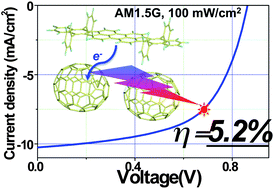Highly efficient organic p–i–n photovoltaic cells based on tetraphenyldibenzoperiflanthene and fullerene C70†
Abstract
In this work, tetraphenyldibenzoperiflanthene (DBP) and

* Corresponding authors
a
Research Center for Organic Electronics and Department of Organic Device Engineering, Yamagata University, 4-3-16 Jonan, Yonezawa, Yamagata 992-8510, Japan
E-mail:
d_yokoyama@yz.yamagata-u.ac.jp, ziruo@yz.yamagata-u.ac.jp
b
Department of Materials Science and Engineering, University of California-Los Angeles, Los Angeles, CA 90095, USA
E-mail:
yangy@ucla.edu
In this work, tetraphenyldibenzoperiflanthene (DBP) and

 Please wait while we load your content...
Something went wrong. Try again?
Please wait while we load your content...
Something went wrong. Try again?
Z. Wang, D. Yokoyama, X. Wang, Z. Hong, Y. Yang and J. Kido, Energy Environ. Sci., 2013, 6, 249 DOI: 10.1039/C2EE22952H
To request permission to reproduce material from this article, please go to the Copyright Clearance Center request page.
If you are an author contributing to an RSC publication, you do not need to request permission provided correct acknowledgement is given.
If you are the author of this article, you do not need to request permission to reproduce figures and diagrams provided correct acknowledgement is given. If you want to reproduce the whole article in a third-party publication (excluding your thesis/dissertation for which permission is not required) please go to the Copyright Clearance Center request page.
Read more about how to correctly acknowledge RSC content.
 Fetching data from CrossRef.
Fetching data from CrossRef.
This may take some time to load.
Loading related content
